
|

By chance Zillmer saw old photos of human foot prints next to those of dinosaurs in a local museum in New Mexico. According the statement of the museum’s manageress such traces were found at three different locations in the New Mexico, Oklahoma and Texas triangle. Zillmer documents in "Errors of Earth’s history" a sequence of such traces in the proximity of Clayton.
|
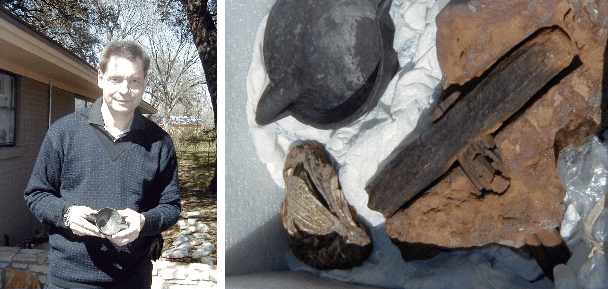
The fossilized hammer from the dinosaur age, described extensively in "Darwin’s Mistake" (recent photo on the right during Zillmer’s visit in Glen Rose 2001) is object of passionate controversies, as this relatively modern looking hammer, named the London artefact, after its discovery in the year 1934, embedded in limestone. Even after opening of the rock the handle of petrified wood (!) remains entrapped by rock. The steel of the hammer head consists of 97% pure iron without any addition of carbon. It is indeed possible to produce pure iron, but in this case we are talking about steel, proven by radiograms, that its structure is directional, and thus, graded. We are until today technically not able to produce such a pure steel.
The photo on the left shows Zillmer with a kind of iron beaker, which in 1912 fell out of a big chunk of coal while crushing it. The coal came from the Oklahoma-Mine in Wilburton and is supposed to be 300 million years old. Exhibited at the Creation Evidence Museum in Glen Rose.
|
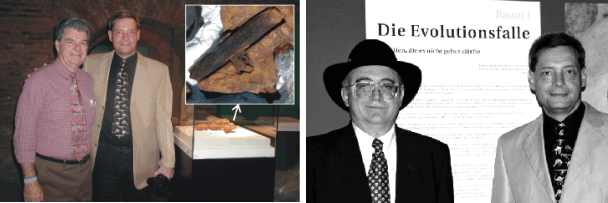
Dr. Carl Baugh and Hans-Joachim Zillmer in front of the London artefact during the exhibition "Unsolved Mysteries" presenting the hammer in Europe for the first time. Picture right: Michael Cremo (author of "Forbidden Archaeology" and Hans-Joachim Zillmer after their speeches during the opening of the exhibition "Unsolved Mysteries" in Vienna. Cremo presented discoveries with human relics from geologic layers of the past 600 million years, therefore, also from times of the dinosaurs – if the geologic time table is correct.
|
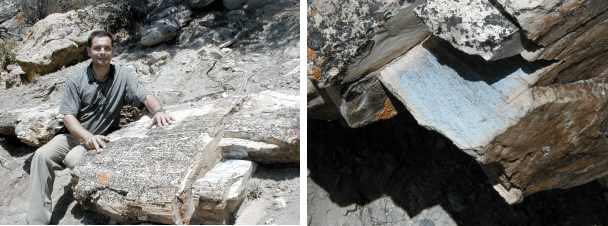
Zillmer during the excavation of a Stegosaurus in Colorado next to a fossilized tree, which apparently was pressed into an oval shape and consists of minerals within (picture right). Can a tree be squeezed in such a way? The riddle is discussed in „Mistake Earth Science “ |
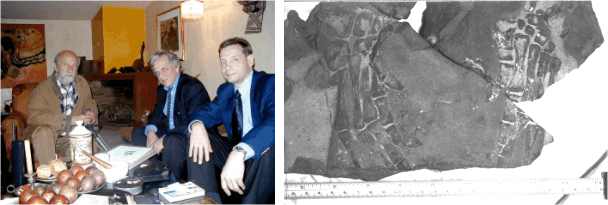
Dr. Willibald Katzinger (middle), Director of the Nordico-Museum in Linz (Austria) and Hans-Joachim Zillmer with Professor Guitierrez Lega in Bogota (Columbia). In his collection there is a hand and a foot of a human being shrink-wrapped in lydite, as it was established by scientists in Vienna. The stone lydite dates from the Mesozoic, the age of the dinosaurs, and was found next to other correspondingly old fossils in an altitude of 2000 meters in Columbia.
|
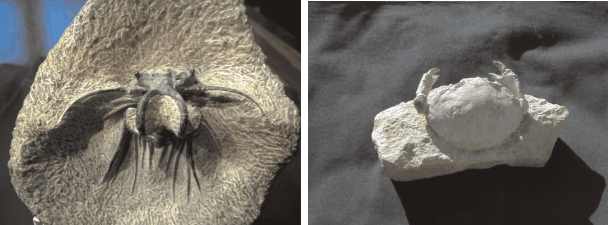
This for more than 250 million years extinct trilobite (left) and the supposedly 45 million years ago fossilized crab from Verona (Italy), in Zillmer’s fossil collection, were quickly preserved by catastrophic circumstances, as they would otherwise be decayed. Fossilizations require rapid conservation under exclusion of air, as the biologic tissue will otherwise decay. According to official conception fossilizations take extremely long, because they are located in geological layers for which a long generation period is proclaimed. According to Zillmer on the one hand the fossilization happens very quickly and, apart from that, the previously soft animal naturally hardens, because it was encased. The geologic layer according to Zillmer consequently hardens as fast as concrete and not over a long period of time. From: "Mistake Earth Science "
|
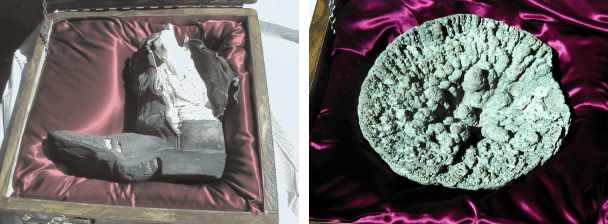
In the 1960’s this leg was fossilized, photographed by Zillmer in 2002. The boot’s leather was not petrified. Also it is questionable, how a jellyfish (picture right) can be fossilized, if these processes run slowly. Zillmer’s conclusion: Fossilisations proceed rapidly. From "Mistake Earth Science ".
|
|